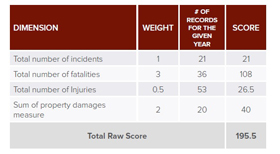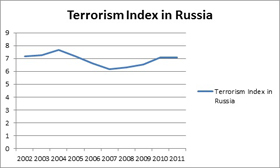Interview
Over the last decade the Middle East, North Africa and Asia Pacific have been the regions most affected by terrorism, while North America has been the least likely region to suffer from a terrorist attack. Indeed, since 9/11 terrorist acts in the U.S., like the ones at the Boston Marathon, have been rare. The world has not yet found the effective strategy to completely get rid of the terrorism, but the Institute for Economics and Peace suggests that measuring terrorism can help us understand its nature and prevent it better. In this interview Kevin Clements, member of the Research Committee of the Institute for Economics and Peace, speaks about terrorism trends over the past decade, explains Index’s methodology and comments on the Terrorism Index in Russia.
Interview
Even though the number of global terrorist incidents has steadily increased, the number of fatalities has declined by 25% since 2007. Over the last decade the Middle East, North Africa and Asia Pacific have been the regions most affected by terrorism, while North America has been the least likely region to suffer from a terrorist attack. Indeed, since 9/11 terrorist acts in the U.S., like the ones at the Boston Marathon, have been rare. The world has not yet found the effective strategy to completely get rid of the terrorism, but the Institute for Economics and Peace suggests that measuring terrorism can help us understand its nature and prevent it better. Since 2002 the Institute has been producing the Global Terrorism Index (GTI) that systematically rank and compare 158 countries according to the impact of terrorism.
In this interview Kevin Clements, member of the Research Committee of the Institute for Economics and Peace, speaks about terrorism trends over the past decade, explains Index’s methodology and comments on the Terrorism Index in Russia.
Interviewee: Kevin Clements, Director of the New Zealand Centre for Peace and Conflict Studies, Member of the Research Committee of the Institute for Economics and Peace
Interviewer: Maria Prosviryakova, Russian International Affairs Council
What key trends in terrorism have been discovered for the past 10 years?
Well, there have been a rising number of successful attacks over the last decade. In 2011, 91% of terrorist attacks were successful: 4564 terrorist incidents took place globally, resulting in 7473 deaths and 13961 injuries.
If you just use those bold figures it looks like you need to worry about the terrorist threat, but you really do not. Even though the impact of terror is distributed around the world, it has had very specific geographic concentrations. In 2011, the areas most impacted by terrorism were the Middle East, India, Pakistan and Russia. North America has often been perceived as a major target for terrorist attacks, but since 2002 it has been the least likely region to suffer from terrorism, with a fatality rate 19 times lower than Western Europe. Only 31 nations (such as North Korea, Mongolia, Cuba, Lithuania, etc) did not experience a terrorist incident between 2002 and 2011.
If we look at terrorists targets, most terrorist attacks are directed at private citizens, government facilities and police, which respectively account for 29%, 17% and 14% of all incidents. It is interesting, that military personnel and installations were only targeted in 4% of terrorist incidents with transportation and businesses being targeted more frequently. Religious figures and institutions suffered in 3% and 2% of cases respectively.
In the context of economic development, most terrorist activity is concentrated in in lower middle income countries. Among the top ten countries most affected by terrorism seven countries are lower middle income, whereas only two (Afghanistan and Somalia) are low income and one (Russia ) is an upper middle income country. Lower middle income countries have a 50% higher rate of attacks than low income countries. Thus suggesting that poverty is not a primary driver of terrorism, and that high income and upper middle income countries have the lower likelihood of being attacked.
It is really a confirmation of Richard Schaefer’s relative deprivation thesis. The thesis infers that it is not the most impoverished nations which engage in terrorist activities, rather it is the countries which either rise or fall in economic activity. Individuals in such countries are more likely to have the feeling of frustration that comes from comparison to social norms and from being unable to afford things that one believes he deserves to have. Those are the countries that are most affected by terrorist incidents.
In terms of political regimes, countries with a hybrid regime of government are most affected by terrorism. (Hybrid regimes are the regimes that have a mixture of democratic and authoritarian characteristics). Hybrid regimes account for 46% of incidents, 54% of fatalities and 60% of all injuries. Flawed democracies are the government type with the second highest level of terrorism. Analysis also shows that most terrorist attacks usually occur in the context of a wider conflict situation.
What methodology is used to calculate the Global Terrorism Index?
The Global Terrorism Index is based on data from the Global Terrorism Database which is the most comprehensive dataset on terrorist activity with over 104,000 cases of terrorist attacks codified.
Each country’s yearly score uses four indicators:
- Total number of terrorist incidents in a given year.
- Total number of fatalities caused by terrorism in a given year.
- Total number of injuries caused by terrorism in a given year.
- The approximate level of total property damage from terrorist incidents in a given year.
Each of the indicators is weighted differently. For example, the greatest weighting is attributed to a fatality. In order to account for the lasting psychological effect that terrorist acts have on a society in terms of fear and subsequent security response, a five year weighted average for each country is calculated. For instance, 9/11 attack deeply traumatized the United States and generated enormous anti-terrorist activities. 2011 terrorist attacks in Norway also will continue to have a psychological impact on the population for many years to come.
What does the Index dynamics indicate about the level of terrorism in Russia? How is it comparable with global trends?
Russia accounted for 4% of the global terrorist incidents. In 2004 Russia had received second highest score out of 158 countries, which was driven by the Beslan School Hostage crisis that claimed 344 lives. It was the third highest ranked incident (after the attacks in Nepal and Spain in 2004) since 2002.
In 2010 the number of terrorist incidents suddenly increased in Russia. Its rank went from 12th to 7th from 2009 to 2010 with the most numerous attacks related to Chechen Rebels and the Caucasus Emirate. In Russia private citizens are not the main targets of terrorist activities, as most attacks are either against the police or the government. Over 75% of the attacks were armed assaults and explosions. 10% of the attacks were assassinations suggesting that they were of a political nature. The dispute over Chechnya continues to be the main source of terrorist violence in Russia.
How does the information provided by the Index help to address the global terrorism problem?
The Global Terrorism Index can be a very useful tool for policy makers in their efforts to tackle terrorism. Governments can draw interesting conclusions from this data. Such as, that higher levels of terrorism strongly correlate with low political stability, low intergroup cohesion, human rights violations and with high levels of group grievances.
Thus, initiatives focusing on improving political stability, increasing respect for human rights, reducing tensions related to group grievances and strengthening intergroup cohesion are the ways to address root causes of terrorism.
Mr. Clements, thank you so much for this interview.









